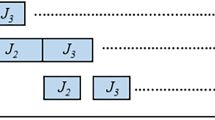Abstract
This paper deals with two most important problems arising in sequencing mixed-model assembly lines. One problem is to keep the line's workstations loads as constant as possible (the 'car sequencing problem') while the other is to keep the usage rate of all parts fed into the final assembly as constant as possible (the 'level scheduling problem'). The first problem is a difficult constraint-satisfaction problem while the second requires to optimize a nonlinear objective function. The contribution of this paper is twofold: First, we describe a branching scheme and bounding algorithms for the computation of feasible sequences for the car sequencing problem. Second, we present an algorithm which can optimize a level scheduling objective while taking care of the car sequencing constraints. Computational results are presented which show that feasible sequences can be obtained quickly for large problem instances.
Similar content being viewed by others
References
Bard, J. F., A. Shtub, and S. B. Josh, “Sequencing mixed-model assembly lines to level parts usage and minimize line length,” International Journal of Production Research, 32, 2431–2454 (1994).
Bolat, A., “Efficient methods for sequencing minimum job sets on mixed model assembly lines,” Naval Research Logistics, 44, 419–437 (1997).
Dincbas, M., H. Simonis, and P. van Hentenryck, “Solving the car-sequencing problem in constraint logic programming,” pp. 290–295, in Proceedings of the European Conference on Artificial Intelligence (ECAI-88), München, (1988).
Drexl, A. and C. Jordan, “Materialflußorientierte Produktionssteuerung bei Variantenfließfertigung,” Zeitschrift für betriebswirtschaftliche Forschung, 47, 1073–1087 (1995).
Drexl, A. and A. Kimms, “Sequencing JIT mixed-model assembly lines under station-load and part-usage constraints,” Management Science, 47, 489–491 (2001).
Inman, R. R. and R. L. Bulfin, “Sequencing JIT mixed-model assembly lines,” Management Science, 37, 901–904 (1991).
Kim, Y. K., C. J. Hyun, and Y. Kim, “Sequencing in mixed model assembly lines: A genetic algorithm approach,” Computers & Operations Research, 23, 1131–1145 (1996).
Kis, T., “On the complexity of the car sequencing problem,” Operations Research Letters, 32, 331–335 (2004).
Kubiak, W., “Minimizing variation of production rates in just-in-time systems: a survey,” European Journal of Operational Research, 66, 259–271 (1993).
Kubiak, W., S. Sethi, “A note on ‘Level schedules for mixed-model assembly lines in just-in-time production systems',” Management Science, 37, 121–122 (1991).
Miltenburg, G. J., “Level schedules for mixed-model assembly lines in just-in-time production systems,” Management Science, 35, 192–207 (1989).
Monden, Y., Toyota Production System—An Integrated Approach to Just-in-Time. Chapman & Hall, Cheriton House/UK, 3rd edition (1998).
Parello, B. D. “CAR WARS: The (almost) birth of an expert system,” AI Expert, 3, 60–64 (1988).
Parello, B. D., W. C. Kabat, and L. Wos, “Job-shop scheduling using automated reasoning: A case study of the car-sequencing problem,” Journal of Automated Reasoning, 2, 1–42 (1986).
Scholl, A. Balancing and Sequencing of Assembly Lines. Physica, Heidelberg, 2. edition, 1999.
Steiner, G.and J. S. Yeomans, “Level schedules for mixed-model, just-in-time processes,” Management Science, 39, 728–735 (1993).
Sumichrast, R. T. and E. R. Clayton, “Evaluating sequences for paced, mixed-model assembly lines with JIT component fabrication,” International Journal of Production Research, 34, 3125–3143 (1996).
Tsai, L.-H. “Mixed-model sequencing to minimize utility work and the risk of conveyor stopping,” Management Science, 41, 485–495 (1995).
Yano, C. A. and R. M. V. Rachamadugu, “Sequencing to minimize work overload in assembly lines with product options,” Management Science, 37, 572–586 (1991).
Zeramdini, W., H. Aigbedo, and Y. Monden, “Bicriteria sequencing for just-in-time mixed-model assembly lines,” International Journal of Production Research, 38, 3451–3470 (2000).
Zhang, Y., P. B. Luh, K. Yoneda, T. Kano, and Y. Kyoya, “Mixed-model assembly line scheduling using the Lagrangian relaxation technique,” IIE Transactions, 32, 125–134 (2000).
Author information
Authors and Affiliations
Corresponding author
Rights and permissions
About this article
Cite this article
Drexl, A., Kimms, A. & Matthießen, L. Algorithms for the car sequencing and the level scheduling problem. J Sched 9, 153–176 (2006). https://doi.org/10.1007/s10951-006-7186-9
Issue Date:
DOI: https://doi.org/10.1007/s10951-006-7186-9




